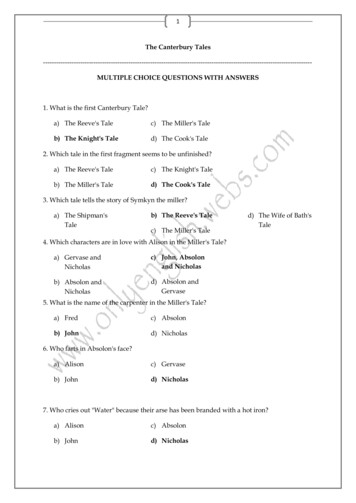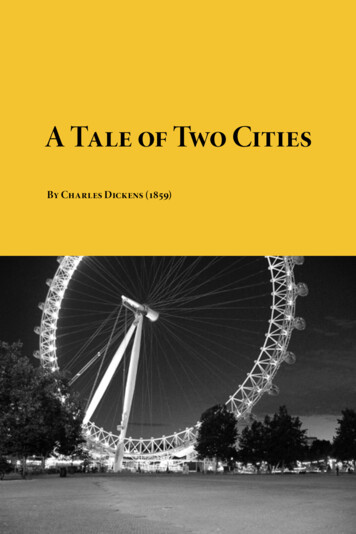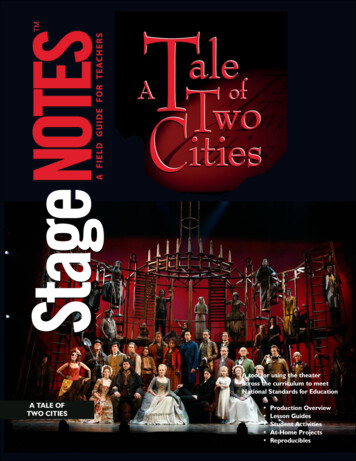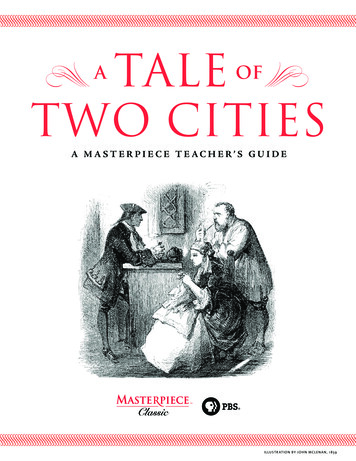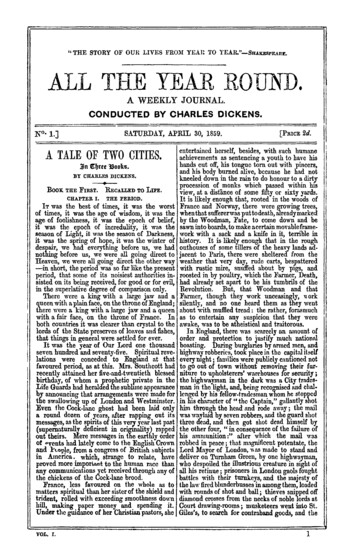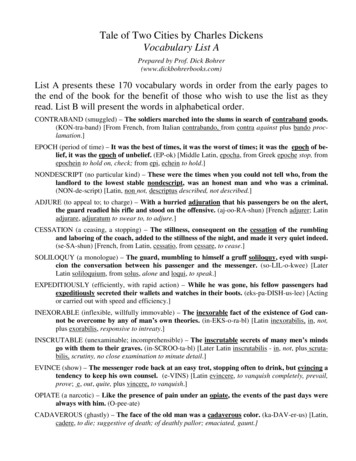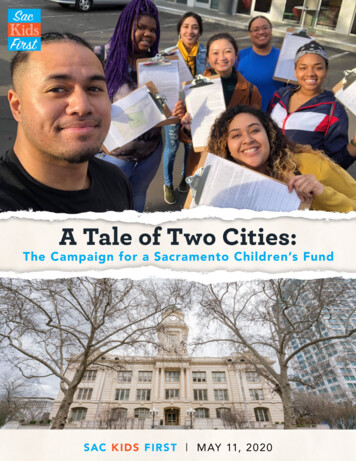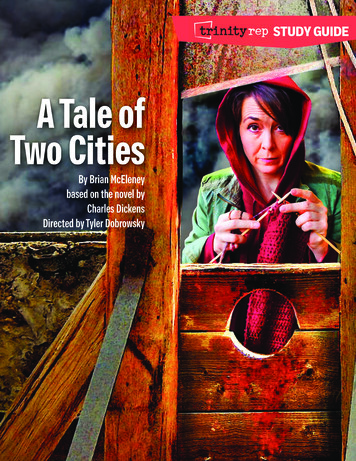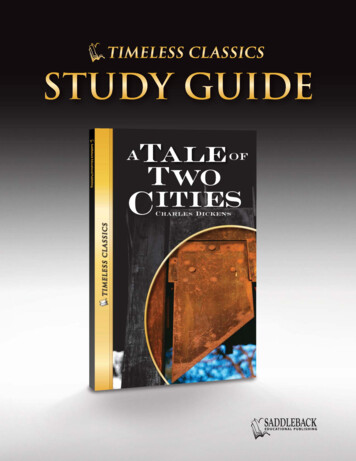
Transcription
STUDY GUIDE
STUDY GUIDELiterature Set 1 (1719-1844)A Christmas CarolThe Count of Monte CristoFrankensteinGulliver’s TravelsThe Hunchback of Notre DameThe Last of the MohicansOliver TwistPride and PrejudiceRobinson CrusoeThe Swiss Family RobinsonThe Three MusketeersLiterature Set 2 (1845-1884)The Adventures of Huckleberry FinnThe Adventures of Tom SawyerAround the World in 80 DaysGreat ExpectationsJane EyreThe Man in the Iron MaskMoby DickThe Prince and the PauperThe Scarlet LetterA Tale of Two Cities20,000 Leagues Under the SeaLiterature Set 3 (1886-1908)The Call of the WildCaptains CourageousDraculaDr. Jekyll and Mr. HydeThe Hound of the BaskervillesThe Jungle BookKidnappedThe Red Badge of CourageThe Time MachineTreasure IslandThe War of the WorldsWhite FangCopyright 1999, 2011 by Saddleback Educational PublishingAll rights reserved. No part of this book may be reproduced or transmitted in any form or by any means, electronic or mechanical, includingphotocopying, recording, scanning, or by any information storage and retrieval system, without the written permission of the publisher.Pages labeled with the statement Saddleback Educational Publishing 2011 are intended for reproduction. Saddleback EducationalPublishing grants to individual purchasers of this book the right to make sufficient copies of reproducible pages for use by all students of asingle teacher. This permission is limited to a single teacher, and does not apply to entire schools or school systems.ISBN-13: 978-1-61651-152-4ISBN-10: 1-61651-152-4eBook: 978-1-60291-883-2Printed in the United States of America15 14 13 12 11 1 2 3 4 5
Contents Notes to the Teacher . 4Facts About the Author . 5Facts About the Times . 6Facts About the Characters . 6Chapter Summaries . 7Answer Key. 10Literary Glossary . 12CHAPTER EXERCISES12345678910111213Words and Meanings, Ch. 1 . 141415Words and Meanings, Ch. 7 . 271617181920212223Words and Meanings, Ch. 8 . 2924Comprehension Check, Ch. 11 . 37Comprehension Check, Ch. 8 . 30Words and Meanings, Ch. 9 . 31Synonyms and Antonyms, Ch. 9 . 32Personalizing the Story, Ch. 9 . 33Words and Meanings, Ch. 10 . 34Inference, Ch. 10 . 35Words and Meanings, Ch. 11 . 36Character Study, Ch. 1 . 15END-OF-BOOK EXERCISESWords and Meanings, Ch. 2 . 162526Book Sequence . 3826Final Exam, Part 2 . 40Comprehension Check, Ch. 2 . 17Words and Meanings, Ch. 3 . 18Cause and Effect, Ch. 3 . 19Final Exam, Part 1 . 39Words and Meanings, Ch. 4 . 20UNIVERSAL EXERCISESInference, Ch. 4 . 212728293031323333Words and Meanings, Ch. 5 . 22Sequence of Events, Ch. 5 . 23Synonyms and Antonyms, Ch. 5. 24Words and Meanings, Ch. 6 . 25Idioms, Ch. 6 . 26Cause and Effect, Ch. 7 . 28Beyond the Text . 41Plot Study . 42Theme Analysis . 43Character Study . 44Vocabulary Study. 45Glossary Study . 46Book Review, Part 1 . 47Book Review, Part 2 . 48
TIMELESS CLASSICSNOTES TO THE TEACHERTHE NOVELSTimeless Classics were expressly designed tohelp struggling readers gain access to some ofthe world’s greatest literature. While retainingthe essence and stylistic “flavor” of the original,each novel has been expertly adapted to areading level that never exceeds grade 4.0.An ideal introduction to later investigationsof the original works, Timeless Classicsutilize a number of strategies to ensure theinvolvement of struggling readers: airy,uncomplicated page design; shortenedsentences; easy-reading type style; eliminationof archaic words and spellings; shortened totalbook length; and handsome illustrations.To further engage struggling readers, someof our Timeless Classics titles are available in anew and exciting graphic format, which canbridge literacies and build complex readingskills—a perfect opportunity for differentiation.THE STUDY GUIDESThe Timeless Classics Study Guides providea wealth of reproducible support materials to helpstudents extend the learning experience. Featuresinclude critical background notes on both theauthor and the times, character descriptions,chapter summaries, and eight “universal”exercises that may be used for any TimelessClassic or Saddleback Illustrated Classic.In addition to the universal exercises, 26title-specific activities are included to review,test, or enrich the student’s grasp of importantvocabulary and concepts. These reproducibleworksheets are designed to be used chapter-bychapter as the student’s reading of the novelproceeds. At least two exercises are providedfor each book chapter. One of the two alwaysfocuses on key vocabulary. The other may bea simple comprehension check or present animportant literary concept.4Research shows that the most effective wayto improve comprehension is to teach studentsstrategies. The foundation of any comprehensionstrategy requires knowledge of the skills foundin these activities including: main idea, notingdetails, drawing conclusions, finding thesequence, cause and effect, making inferences,and more. A two-page final exam is also includedin every Timeless Classics Study Guide.USING THE STUDY GUIDESBefore assigning any of the reproducibleexercises, be sure your students each have apersonal copy of the Glossary and the FactsAbout the Author and About the Times. Byorganizing the reading process in this way, youwill be able to set a purpose for reading andactivate prior knowledge. The Facts About theAuthor and About the Times lend themselvesto any number of writing or research projectsyou may wish to assign. To further preview thenovel, you may wish to review the Facts Aboutthe Characters. Students will also need to befamiliar with many of the literary terms in orderto complete the worksheets.The title-specific exercises may be usedas a springboard for class discussions androle-playing. Alternatively, you may wish toassign some exercises as homework and othersduring the closing minutes of a class period.All exercises in this Guide are designed toaccommodate independent study as well asgroup work. The occasional assignment of studypartners or competitive teams often enhancesinterest and promotes creativity. Oral languageactivities, such as paraphrasing or summarizinga part of the story, provide an interventionopportunity to strengthen oral language skillsand, in turn, strengthen reading skills.
A TALE OF TWO CITIESFACTS ABOUT THE AUTHORCHARLES DICKENS(1812–1870)EARLY LIFEBorn in Portsmouth, England, CharlesDickens endured a difficult, unhappychildhood—much like the children in hisnovels. When his father, a clerk, was throwninto debtor’s prison, young Charles was sentto work in a shoe polish factory. In later yearshe was to say that his parents’ failure toeducate him was his greatest disappointment.After the age of 14, he never returned toschool.generate income. But he received an evengreater reward: he said that he laughed andcried over A Christmas Carol as he did noother story.PROFESSIONAL CAREERCharles Dickens is considered by many tobe the greatest English novelist. Although hiswork is sometimes criticized as sentimental,his stature as a great humorist and creator ofcharacters is unparalleled. His imaginativeuse of detail, odd gestures, expressions,speech patterns, and physical characteristicshas brought his characters to life for millionsof readers. As a social critic, he attackedhypocrisy, injustice, and cruelty as few othernovelists have had the skill to do.A lifelong hard worker, Dickens held jobsas an office boy and then as a newspaperreporter of debates in Parliament. Under thepen name Boz, he wrote humorous satireson daily life for a magazine. This seriesimmediately became popular, encouragingDickens to write his first novel, The PickwickPapers—which was published when he was24 years old. With the great success of thisnovel, Dickens’ literary career was launched.In Oliver Twist, his next novel, Dickensbegan his lifelong crusade against socialconditions that grossly abuse the poor,especially children. While on a reading tourin the United States, he also spoke out forthe abolition of slavery.The publication of A Christmas Carolin 1843 met with sensational success. Asthe father of 10 children, Dickens freelyadmitted that he wrote the book in order toOTHER WORKSAmong the best known of his 20novels are David Copperfield, A Taleof Two Cities, Hard Times, and GreatExpectations.The Victorian Era, when Dickens wrote,is sometimes called “the age of Dickens”because his characters and ideas so wellexemplify life at this time.LATER LIFEAt the age of 58, Dickens died inEngland while working on his novel, TheMystery of Edwin Drood. He was buried inWestminster Abbey.5
A TALE OF TWO CITIESFACTS ABOUT THE TIMESIn 1812, when Charles Dickens wasborn . . .Napoleon marched on Moscow, JamesMadison was elected President of the UnitedStates, the first billiards parlor opened inEngland, the United States declared war onBritain, and Beethoven wrote his Seventhand Eighth Symphonies.In 1859, when A Tale of Two Cities waspublished . . .Oregon became a state, Abraham Lincolnwas running for President, WashingtonIrving died, Arthur Conan Doyle was born,a Frenchman crossed Niagara Falls on atightrope, and the storage battery and thesteamroller were invented.In 1870, when Charles Dickensdied . . .John D. Rockefeller founded the StandardOil Company, Jules Verne published TwentyThousand Leagues Under the Sea, Robert E.Lee died, Lenin was born, and P.T. Barnumwas preparing to open “The Greatest Showon Earth” in Brooklyn.FACTS ABOUT THE CHARACTERSMR. LORRYCHARLES ST. EVREMONDE / DARNAYA representative of Tellson’s Bank and afriend of the ManettesYoung French nobleman who renouncedhis ancestral rights and moved to England;later married to Lucie ManetteLUCIE MANETTEMISS PROSSDaughter of Dr. Manette who later marriesCharles Darnay; a pretty young woman,blond and blue eyedFormer nursemaid and present servant ofLucie ManetteMONSIEUR DEFARGESYDNEY CARTONKeeper of a wine shop in Paris; husbandof Madame Defarge; a leader of the CitizensAn English lawyer who looks muchlike Charles Darnay; a man who is ruininghis life with drinkMADAME DEFARGEKeeper of a wine shop in Paris; wife ofDefarge; a bitter woman bent on revengeLITTLE LUCIEDR. MANETTETHE MARQUIS ST. EVREMONDEFormer prisoner at the Bastille; a physician;Lucie’s father6Young daughter of Lucie and CharlesA cruel, cold-hearted French nobleman;uncle of Charles Darnay
A TALE OF TWO CITIESCHAPTER SUMMARIESCHAPTER 1The time and place of the action are:England and France in 1775, a time ofgovernment upheaval. Mr. Lorry, an employeeof Tellson’s Bank, arrives in Dover, England,to meet with a young woman named LucieManette. He tells Lucie that her father hasnot died as she had been told, but insteadhas wrongfully been imprisoned in theBastille for the past 18 years. Shocked,Lucie agrees to accompany Lorry to Paris sothey can bring her father home to England.In Paris, they find the old man locked in anattic room over the Defarges’ wine shop.They discover that he has lost his health andhis memory.the street. He throws the dead boy’s father acoin to get rid of him, but the coin is angrilytossed back by Defarge, who has seenwhat happened. Charles, the nephew of theMarquis, is waiting when his uncle returnshome to his grand mansion. He fruitlesslybegs the cruel old man to change his ways,but the Marquis does not listen. That nightthe Marquis is stabbed to death in his bed.Back in England, Charles works as a teacherand falls in love with Lucie Manette. Whenhe asks Dr. Manette’s permission to marryher, he also tries to tell the doctor a secret—but the old man does not want to hear it untiltheir wedding day.CHAPTER 2CHAPTER 4Five years later Dr. Manette has regainedhis health and is living comfortably withLucie in London. They are called to testifyagainst a young Frenchman they had meton the boat from France to England. Incourt they speak kindly of the man, CharlesDarnay, and as the trial progresses, yetanother witness against him is discredited.Darnay is finally found innocent when athird witness cannot be certain that the manhe saw “getting secrets from soldiers near amilitary post” is Darnay rather than a lawyer,Sydney Carton, who looks remarkably likeDarnay. At dinner that evening, Cartonbecomes jealous of Darnay’s bright future.In a drunken stupor, he criticizes himself forallowing drink to ruin his life.Sydney Carton declares his love for LucieManette, offering to give his life for her if hehas to. Lucie pities him but is distracted byplans for her wedding to Charles. Just beforethe ceremony Charles tells Dr. Manette histrue name. The doctor is shocked to hearthe name St. Evremonde because it is thisfamily that was responsible for his longimprisonment. He makes Charles promiseto tell no one else. When the Defarges hearthat a member of the St. Evremonde familyhas married Lucie, Madame Defarge addstheir names to her knitted list of people whomust die.CHAPTER 3Speeding down a narrow street in acarriage, the Marquis St. Evremonde isunmoved when his horses run over a child inCHAPTER 5Living in London, Lucie and Charles havea baby girl called Little Lucie. One nightMr. Lorry visits and advises them of furthertrouble brewing in Paris. As they speak, theDefarges are handing out weapons to anangry crowd of workers who are preparing7
A TALE OF TWO CITIESCHAPTER SUMMARIESto storm the Bastille, a hated prison wheremany poor people have been mistreated foryears. Soon the mob overwhelms the guardsand floods into the prison courtyard. Defargeleads some men to Cell 105, Dr. Manette’sformer cell. There they hunt for and findthe doctor’s hidden diary of those years.Madame Defarge chops off the warden’shead with her axe, and many other acts ofterror and violence quickly follow.CHAPTER 6Charles receives a letter from his oldservant Gabelle. The letter says that Gabellehas been arrested for managing Charles’sproperty. He begs Charles to come to hisassistance in Paris. Without telling Lucie,Charles hurries to France where he isquestioned by armed workers who now callthemslves Citizens. He is arrested by Defarge,a leader of the Citizens, and detained in jail.When they hear what happened, Lucie, Dr.Manette, Little Lucie, and Miss Pross rushto Paris. Mr. Lorry brings Dr. Manette up todate about the escalating violence and urgesthe doctor to act quickly if he wants to saveCharles from the guillotine.CHAPTER 7Visiting Charles in prison brings backmany sickening memories to old Dr. Manette.When the Defarges deliver a note Charleshas written, Lucie feels some comfort, butshe and Little Lucie are both terrified bythe evil look in Madame Defarge’s eyes.Upon returning from his stay with Charles,Dr. Manette reports that Charles is safe “for8now.” Lucie wonders if she will ever see herhusband again, but then learns that he willbe put on trial the next day. In the meantime,Sydney Carton visits Mr. Lorry to ask fornews and offer any help he can.CHAPTER 8Darnay tells the judge that he gave uphis title years ago and has been earninghis living as a teacher in England. He goeson to explain that he came back to Franceonly because his old friend needed help.Gabelle confirms that this is true. When Dr.Manette, who is an honored man amongthe people because of his 18 years in theBastille, testifies that Charles is a goodand decent man, Darnay is set free. TheCitizens carry him home on their shouldersand a family celebration follows. But thehappy reunion is quickly interrupted astwo armed Citizens burst in and arrestCharles on unnamed charges. Withoutfurther explanation, they drag Charles offinto the night.CHAPTER 9Sydney Carton tells Mr. Lorry that Charleshas again been arrested. Shocked at the news,Mr. Lorry is nonetheless impressed by howwell Carton looks—as if he has somehowpulled himself together. After leaving Mr.Lorry, Carton buys two packets of drugs at achemist’s shop and takes a long, thoughtfulwalk through the city. He remembers hisfather’s funeral and repeats a quotation fromthe Bible about resurrection. Standing on asmall bridge as dawn breaks, Carton seems
strangely at peace with himself. At the trial,a lawyer declares that Darnay is accused notonly by the Defarges, but by Dr. Manette.Against Dr. Manette’s outraged objections,Defarge offers the court the doctor’s prisondiary as proof.CHAPTER 10Defarge reads from Dr. Manette’s diary.The story begins in 1757, when Dr. Manetteis stopped on the street and taken to thehome of the Marquis St. Evremonde. Therehe treats a fatally ill young woman and ayoung man who is dying of stab wounds.Before dying, the young man reveals thatthe Marquis stabbed him, and for manyyears had abused the boy’s whole family.With his dying breath, the boy curses theMarquis and his whole family. In spite of theMarquis’s warning not to tell, Dr. Manettereports the crime in a letter to the police.Shortly thereafter he discovers that his letterhas been intercepted. He is soon arrested bya stranger dressed in black and thrown intothe Bastille without a trial. In his own hand,Dr. Manette has written the following wordsin his diary: “I curse the Marquis and everymember of his family!” On that evidence,Charles is condemned to death. A sad andthoughtful Sydney Carton watches from therear of the courtroom.CHAPTER 11In the Defarges’ wine shop, Sydney Cartonoverhears Madame Defarge vowing to killCharles’s entire family. She tells her husbandthat the family that was so cruelly treated bythe Marquis was hers. Charles rushes to Mr.Lorry, telling him to have a carriage waitingoutside the prison gates at 2 o’clock the nextday. He says Lucie, her daughter, and Dr.Manette should be in the carriage waitingfor him, ready to leave at once for London.Carton gives Lorry his pass. The next day hedrugs Charles in his cell, exchanges clotheswith him, and sends Charles, disguised asCarton, off to the carriage and freedom.Carton himself goes to the guillotine inCharles’s place, saying that his sacrificeis a “far better thing” than he has everdone before.9
1A TALE OF TWO CITIES CHAPTER 1WORDS AND MEANINGSNAMEA.DATECircle the word that correctly completes each sentence from Chapter 1.1. It was the ( season / session ) of light.2. It was the winter of ( discontent / despair ).3. Mr. Lorry told the ( bookkeeper / innkeeper ) he needed another room.4. Although the day was cold and ( dreary / weary ), Mr. Lorry walked forhours.5. The ( cart / carriage ) drove down a narrow, dirty street.6. A wine barrel broke when it hit the rough ( cartwheels / cobblestones ).7. Ragged people were ( hanging / huddled ) outside the door.8. Behind the counter a middle-aged woman sat ( knitting / sewing ).9. Defarge unlocked the ( antique / attic ) room.10. With a ( signal / sigh ), Dr. Manette returned to work.B.Use the clues to complete the crossword puzzle.ACROSS1. a long, deep breath let outwith a soft sound4. hopelessness6. round stones used forpaving streets7. a certain period of time1DOWN2. crowded together3. looping yarn together withlong needles143H45DKIT6CBSNE7R8. space or room just belowthe roof9. gloomy, cheerless2SSI8ASNPC9DAYE5. hotel owner or manager6. horsedrawn buggy or coachSaddleback Educational Publishing 2011 www.sdlback.com
2A TALE OF TWO CITIES CHAPTER 1CHARACTER STUDYNAMEA.B.C.DATEThink about the characters you met in Chapter 1. Choose two words orphrases from the box that describe each character. Write the words on thelines. Hint: You will not use all the ankerangryillformer servantshoemakershopkeeper1. Mr. Lorry2. Lucie Manette3. Defarge4. Dr. Manette5. Madame DefargeWrite a letter to show words spoken by each character.1. Lucie Manettea. “Your father is not in good health, but he is alive.”2. Dr. Manetteb. “It is fear that we wear like a rough shirt.”3. Mr. Lorryc. “105, North Tower.”4. Defarged. “My father died when I was very small.”Write a character’s name to complete each sentence.1. Twenty years ago, did some work for a famousFrench doctor.2. As the well-dressed strangers stepped forward, a cold, unfriendly lookcame into eyes.3. With a sigh, frowned and returned to work.4. said that terrible things were done to thepeople every day.Saddleback Educational Publishing 2011 www.sdlback.com15
A Tale of Two Cities 20,000 Leagues Under the Sea Literature Set 2 (1845-1884) The Call of the Wild Captains Courageous Dracula Dr. Jekyll and Mr. Hyde The Hound of the Baskervilles The Jungle Book Kidnapped The Red Badge of Courage The Time Machine Treasure Island The War of the Worlds White Fang Literature Set 3 (1886-1908) STUDY GUIDE

